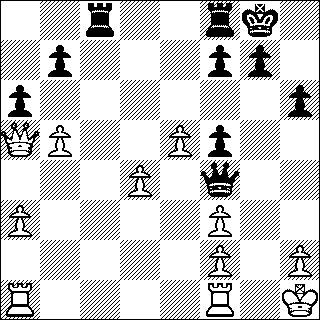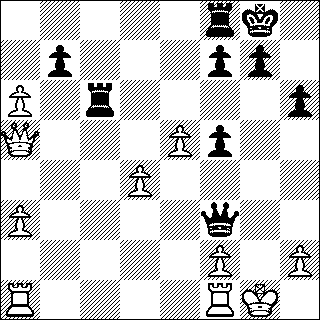
During the game I was really uncertain as to the assessment of this position. White certainly has opportunities to go wrong, but I thought that he might find a move that either forced me take a perpetual check or even worse, trade my a & b-pawns for his d & e-pawns leaving a major piece ending where he had the outside passer. After engaging with CD and Sancho in the comments to Part 2, I'm beginning to feel that Black might be better after all. Nevertheless, there are still several things which aren't clear to me. Once you're done reading this feel free to submit the position to your silicon chess friends and see what they have to say.
With the clocks running, I focused my attention on two moves for White -- Rg1 and Kf2. After 6.Rg1 there seem to be two ideas for Black:
- During the game I was planning on 6...Qxf3+ 7.Rg2 Qd5. Black has threats against a couple Black pawns as well as ideas like Rc4 or Rc2 followed by doubling on the c-file. On the other hand, White may double his rooks on the g-file, forcing Black to keep his queen on the h1-a8 diagonal. In the end, I suspect that this is probably better for Black (though I'm not sure).
- A second idea suggested by CD is 6...Qxf3+ 7.Rg2 axb5 8.Qxb5 Rc6 9.Rag1 Rg6 10.Qf1 Rc8 -/+, but I'm not sure about this as White has other defensive ideas like 9.Kg1 and 9.Qf1 and possibly alternatives to 10.Qf1.
After 6.Kg2 I originally thought that Black would have to take the draw starting with 6.Qg4+, but now I think that 6...Qxd4 7.bxa6 bxa6 8.Qxa6 Qxd5 may be feasible. Sure White has an outside passer, but his King is in the open and his pawn structure is a mess. I think Black, with his more actively placed pieces, probably has good chances of piling up on f3 or f2.
Now on to two moves I didn't spend much time on during the game. 6.Rfe1 fails to 6...Qxf3+ 7.Kg1 Rc2 8.Rf1 Re8! (a nice idea which CD suggested in a different position) and I don't think White can do much to stop Re6-g6.
6.Rfd1 is another matter since in the line above Rc2 can be answered by Rd2. Maybe 6...Qxf3+ 7.Kg1 axb5 is a better approach, but I'm not sure.
Well, as I promised, I don't have all the answers. Nevertheless, I think this was a very instructive position in terms of needing to see beyond the superficial tactic (2.Nxd5) in order to evaluate the position properly. My evaluation of the original position? I'm guessing that when all is said and done it will turn out that Black is better after 5...Qf4. Therefore, in the original position I believe Black is equal to slightly better after 1...Na5! and White probably should have chosen 2.Qd3 instead of 2.Nxd5. So now someone can turn on their computer and let us know the "truth."
What happened in the game? Unfortunately for my opponent, he played the worst plausible move on the board:
6.bxa6?? Qxf3+ 7.Kg1 Rc6! and White resigned.
It's not mate in every line as CD suggested, but it is in some and in the others White wins significant material. I'll leave it as an exercise to the Knights to work out the wins after 7.Rfe1, 7.Rfd1, and 7.Rfc1.

No comments:
Post a Comment